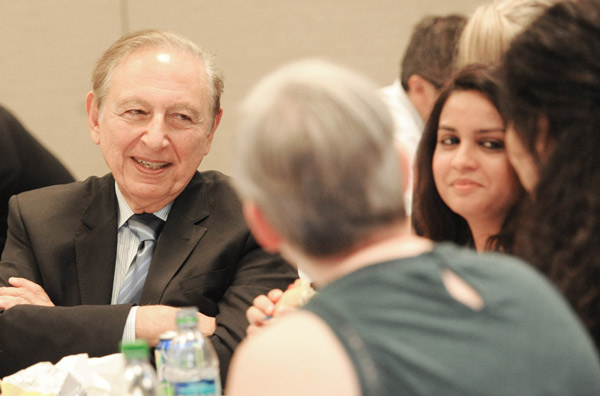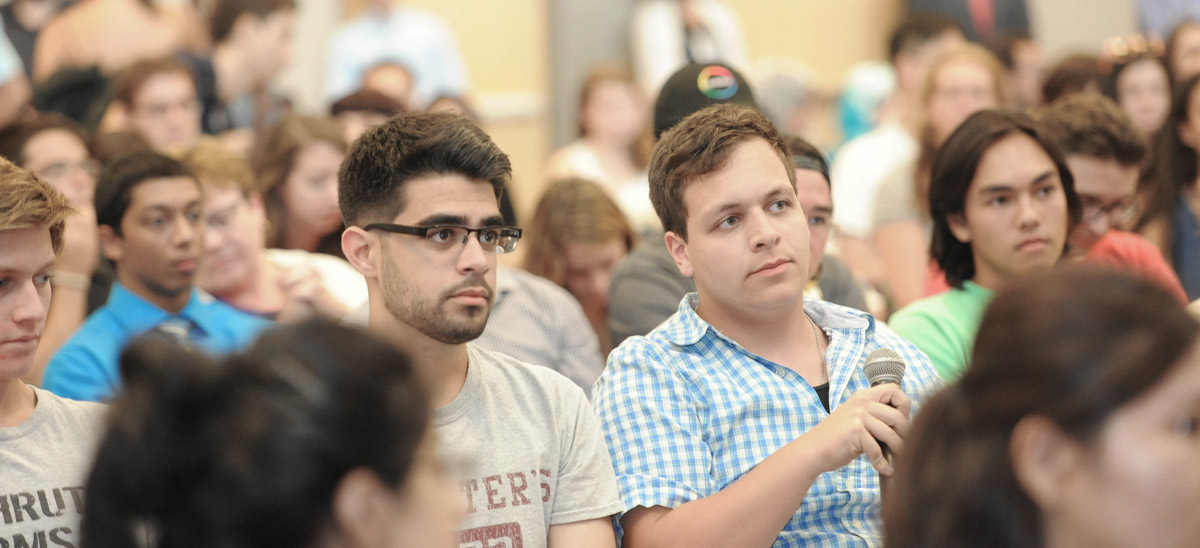
The many biology students who turned out this fall for the annual Biology Graduate Student Research Symposium were excited to have a science superstar in the house.
“Robert Gallo is one of the most famous biologists and virologists in the world,” said Frank Portugal, associate professor and director of the biotechnology program, in introducing the keynote speaker. Gallo, who was the most referenced scientist in the world during the 1980s and 1990s, is a two-time winner (1982 and 1986) of the Albert Lasker Award in Medicine, America’s most prestigious scientific award.

Portugal noted that Gallo was the first to identify a human retrovirus HTLV, the only known human leukemia virus. This was before the AIDS epidemic that gripped the world in the 1980s.
Gallo is internationally recognized for his co-discovery of HIV as the cause of AIDS. In the early 1980s, He and his team also pioneered the development of the HIV blood test. His research also helped physicians develop HIV therapies to prolong the lives of those infected with the virus. Gallo is director of the Institute of Human Virology and professor of medicine and microbiology and immunology at the University of Maryland School of Medicine. He is also co-founder and scientific director of the Global Virus Network.
Before beginning his nearly hour-long address on “A Journey with Blood Cells and Viruses,” Gallo told the large audience gathered in the Great Room of the Edward J. Pryzbyla University Center that he wants students to identify with him, to know that he was once in their shoes. “I told students over lunch of my many catastrophes when I tried to start a research career,” said Gallo. “The first set of experiments I did over and over again in the early years of my career.”
Nnanya Kalu, a fourth-year doctoral student, was seated at Gallo’s table during the student networking lunch during which accomplished scientists, many of them alumni, ate with the students. He said it was helpful to hear about the scientist’s early days in the lab.
“I heard about Dr. Gallo’s work a long time ago when I was in medical school in Nigeria. You can’t talk about HIV research without mentioning his name,” said Kalu. “It was exciting to talk with him about my own research.”
Kalu presented his work on anthrax toxin and how the lipid environment affects its uptake during the morning session of the symposium. He said he chose Catholic University for his doctoral work on bioterrorism because “Dr. Rao is well known and the research being done here speaks for itself.”
The graduate research symposium, said Venigalla Rao, professor of biology and chair of the department, “is an opportunity for our graduate students to gain experience presenting their research and for undergraduate students to see how that process works. It is also an important networking opportunity.”
Rao said there was a buzz in his department before Gallo arrived, especially because he and many of his students are involved in HIV research (see sidebar).

Following the keynote address, Gallo patiently posed for pictures and answered questions from students lined up to meet him.
Leah Henry, a senior biology student, is applying to medical schools. “I’m also interested in doing research. How has having an M.D. helped you as a researcher?” One of the advantages, Gallo said, “is that [as a researcher] you have a greater insight into human disease.”
Kalu was up next. “From the stories you tell, the discovery of HIV was fraught with a lot of myths and drama. How do you as a scientist balance the politics?” Gallo said there is no easy answer. “The activists at first were angry we came up with just the cause. They wanted treatment, a cure. But by late ’85 after therapy became available, making the world an infinitely better place, we became friends.”